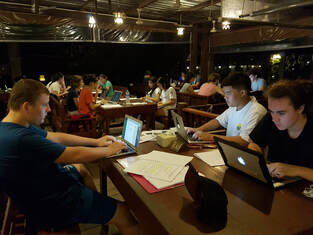IA Report Preparation - Support Resources
From the IB Guide
Students should produce one report of their investigation. The report must not exceed 2,500 words.
Word limit: The following are not included in the word count.
Where work is over the limit, teachers and moderators are advised to stop reading and students are likely to not gain as many marks under criteria such as E and F.
Emphasis: The emphasis of the written report must be analytical and include focus on the method(s) and technologies (if any) employed for information collection, its treatment and analysis. A purely descriptive report and/or a long theoretical introduction must be avoided.
Format: Students are advised to use the following guidelines to format their reports, which will ensure that the reports fulfill the requirements of the criteria. The fieldwork written report must meet the following requirements of organization and presentation.
Word limit: The following are not included in the word count.
- Title page
- Acknowledgments
- Contents page
- Titles and subtitles
- References
- Footnotes—up to a maximum of 15 words each
- Map legends and/or keys
- Labels—of 10 words or less
- Tables—of statistical or numerical data, or categories, classes or group names
- Calculations
- Appendices—containing only raw data and/or calculations
Where work is over the limit, teachers and moderators are advised to stop reading and students are likely to not gain as many marks under criteria such as E and F.
Emphasis: The emphasis of the written report must be analytical and include focus on the method(s) and technologies (if any) employed for information collection, its treatment and analysis. A purely descriptive report and/or a long theoretical introduction must be avoided.
Format: Students are advised to use the following guidelines to format their reports, which will ensure that the reports fulfill the requirements of the criteria. The fieldwork written report must meet the following requirements of organization and presentation.
- The work is concise and within the 2,500-word limit.
- Overall presentation is well structured, with pages numbered.
- All illustrative material is fully integrated into the body of the report and is not relegated to an appendix.
- Figures such as maps, diagrams and tables are numbered and referenced in the text.
- References used for background information follow standard conventions. (Guidance on referencing is given in the earlier section on secondary information.)
Visuals Support |
Website: How to choose the best chart for your data
Website: Excel chart formatting tips
Tips: Visual map making
Website: Excel chart formatting tips
Tips: Visual map making
Article: Trump shows fake hurricane map
Visual Creation Tools
|
|
|
Visuals Website: Resource to support the use of visuals in schools
Map Making
Website: Geographic Maps
Map Creator: Snazzy Maps
Website: Google Earth
Video: Google spreadsheet to map in 2 clicks
Image Creation/ Manipulation Tools
Website: Piktochart
Website: Pixlr Editor
Web Tool : GIMP
Website: Noun Project - Icons for everything
Map Making
Website: Geographic Maps
Map Creator: Snazzy Maps
Website: Google Earth
Video: Google spreadsheet to map in 2 clicks
Image Creation/ Manipulation Tools
Website: Piktochart
Website: Pixlr Editor
Web Tool : GIMP
Website: Noun Project - Icons for everything
Analysis
References & Citations

Additional Resources
Authenticity: Did I plagiarize infographic
